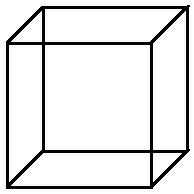Necker cube
The Necker cube is a classic example of an ambiguous figure.
In 1832, the Swiss crystallographer Louis Necker noticed, while examining
crystals, that three-dimensional objects can fluctuate in appearance. He
published pictures of an unusual cube that
appeared to assume different orientations as one looked at it. The effect
works because the drawing of the cube (an orthographic projection) carefully
eliminates all depth cues. In attempting to fit the expected model of a
cube to the picture, our brain must resolve the ambiguity as to which corner
of the cube is closer.
 |


